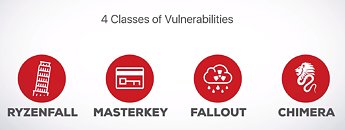- Joined
- Oct 9, 2007
- Messages
- 47,895 (7.38/day)
- Location
- Dublin, Ireland
| System Name | RBMK-1000 |
|---|---|
| Processor | AMD Ryzen 7 5700G |
| Motherboard | Gigabyte B550 AORUS Elite V2 |
| Cooling | DeepCool Gammax L240 V2 |
| Memory | 2x 16GB DDR4-3200 |
| Video Card(s) | Galax RTX 4070 Ti EX |
| Storage | Samsung 990 1TB |
| Display(s) | BenQ 1440p 60 Hz 27-inch |
| Case | Corsair Carbide 100R |
| Audio Device(s) | ASUS SupremeFX S1220A |
| Power Supply | Cooler Master MWE Gold 650W |
| Mouse | ASUS ROG Strix Impact |
| Keyboard | Gamdias Hermes E2 |
| Software | Windows 11 Pro |
CTS Labs, the Israel-based IT security research company behind Tuesday's explosive AMD Ryzen security vulnerabilities report, responded to questions posed by TechPowerUp. One of the biggest of these, which is also on the minds of skeptics, is the ominous lack of proof-of-concept code or binaries being part of their initial public report (in contrast to the Meltdown/Spectre reports that went into technical details about the exploit). CTS Labs stated to TechPowerUp that it has sent AMD, along with other big tech companies a "complete research package," which includes "full technical write-ups about the vulnerabilities," "functional proof-of-concept exploit code," and "instructions on how to reproduce each vulnerability." It stated that besides AMD, the research package was sent to Microsoft, HP, Dell, Symantec, FireEye, and Cisco Systems, to help them develop patches and mitigation.
An unwritten yet generally accepted practice in the IT security industry upon discovery of such vulnerabilities, is for researchers to give companies in question at least 90 days to design a software patch, harden infrastructure, or implement other mitigation. 90 days is in stark contrast to the 24 hours AMD got from CTS Labs. CTS Labs confirmed to TechPowerUp that it indeed shared its research package with AMD (and the other companies) just 24 hours prior to making its report public, but urged those disgruntled with this decision to look at the situation objectively. "If you look at the situation in the following way: right now the public knows about the vulnerabilities and their implications, AMD is fully informed and developing patches, and major security companies are also informed and working on mitigation."

This is in contrast to the unintentional consequence of keeping Meltdown/Spectre away from the public domain for over half a year, allowing Intel's senior executives to dump company stock, and for big cloud computing providers to harden their infrastructure, giving themselves a competitive advantage over smaller providers. But unlike with Meltdown/Spectre, these vulnerabilities aren't industry-wide (i.e. they don't affect Intel), placing AMD at a disadvantage in both the stock markets, and in the retail markets.
CTS Labs, through the sequence of its actions, has attempted to shift the burden of proof from itself to AMD, which is extremely uncommon in the IT security industry. With the lack of proof-of-concept of these vulnerabilities in the public domain, an environment of fear, uncertainty, and doubt (FUD) is being developed, with AMD being occupied with testing its chips for these vulnerabilities, and still far away from releasing patches, if the vulnerabilities are real. This places anyone with a shorting position against AMD stock at a distinct advantage. The strategy of AMD investor relations and corporate communications should now be to allay many of those fears among people without access to the proof-of-concept, and to ask investors to refrain from giving in to FUD.
View at TechPowerUp Main Site
An unwritten yet generally accepted practice in the IT security industry upon discovery of such vulnerabilities, is for researchers to give companies in question at least 90 days to design a software patch, harden infrastructure, or implement other mitigation. 90 days is in stark contrast to the 24 hours AMD got from CTS Labs. CTS Labs confirmed to TechPowerUp that it indeed shared its research package with AMD (and the other companies) just 24 hours prior to making its report public, but urged those disgruntled with this decision to look at the situation objectively. "If you look at the situation in the following way: right now the public knows about the vulnerabilities and their implications, AMD is fully informed and developing patches, and major security companies are also informed and working on mitigation."

This is in contrast to the unintentional consequence of keeping Meltdown/Spectre away from the public domain for over half a year, allowing Intel's senior executives to dump company stock, and for big cloud computing providers to harden their infrastructure, giving themselves a competitive advantage over smaller providers. But unlike with Meltdown/Spectre, these vulnerabilities aren't industry-wide (i.e. they don't affect Intel), placing AMD at a disadvantage in both the stock markets, and in the retail markets.
CTS Labs, through the sequence of its actions, has attempted to shift the burden of proof from itself to AMD, which is extremely uncommon in the IT security industry. With the lack of proof-of-concept of these vulnerabilities in the public domain, an environment of fear, uncertainty, and doubt (FUD) is being developed, with AMD being occupied with testing its chips for these vulnerabilities, and still far away from releasing patches, if the vulnerabilities are real. This places anyone with a shorting position against AMD stock at a distinct advantage. The strategy of AMD investor relations and corporate communications should now be to allay many of those fears among people without access to the proof-of-concept, and to ask investors to refrain from giving in to FUD.
View at TechPowerUp Main Site



 )
)

